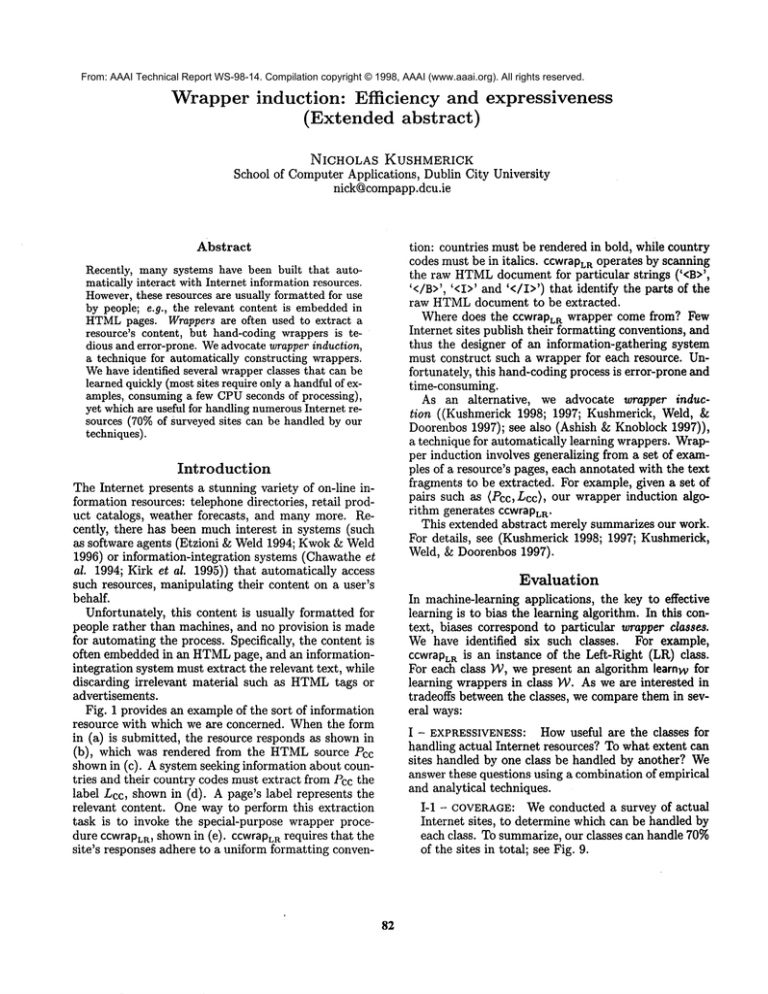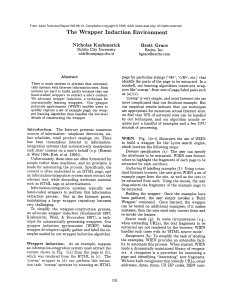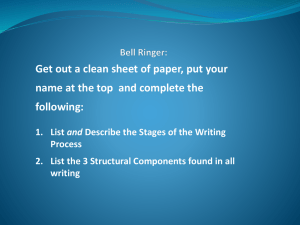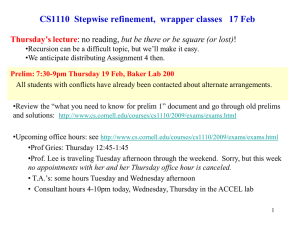
From: AAAI Technical Report WS-98-14. Compilation copyright © 1998, AAAI (www.aaai.org). All rights reserved.
Wrapper induction:
Efficiency
and expressiveness
(Extended abstract)
NICHOLAS KUSHMERICK
School of Computer Applications, Dublin City University
nick@compapp.dcu.ie
Abstract
Recently, manysystems have been built that automatically interact with Internet information resources.
However,these resources are usually formatted for use
by people; e.g., the relevant content is embeddedin
HTML
pages. Wrappers are often used to extract a
resource’s content, but hand-coding wrappers is tedious and error-prone. Weadvocate wrapperinduction,
a technique for automatically constructing wrappers.
Wehave identified several wrapperclasses that can be
learned quickly (mostsites require only a handful of examples, consuminga few CPUseconds of processing),
yet whichare useful for handling numerousInternet resources (70%of Surveyedsites can be handled by our
techniques).
Introduction
The Internet presents a stunning variety of on-line information resources: telephone directories, retail product catalogs, weather forecasts, and many more. Recently, there has been much interest in systems (such
as software agents (Etzioni & Weld 1994; Kwok& Weld
1996) or information-integration
systems (Chawathe et
al. 1994; Kirk et al. 1995)) that automatically access
such resources, manipulating their content on a user’s
behalf.
Unfortunately, this content is usually formatted for
people rather than machines, and no provision is made
for automating the process. Specifically, the content is
often embedded in an HTMLpage, and an informationintegration system must extract the relevant text, while
discarding irrelevant material such as HTMLtags or
advertisements.
Fig. 1 provides an example of the sort of information
resource with which we are concerned. Whenthe form
in (a) is submitted, the resource responds as shown
(b), which was rendered from the HTMLsource Pcc
shownin (c). A system seeking information about countries and their country codes must extract from Pcc the
label Lcc, shown in (d). A page’s label represents the
relevant content. One way to perform this extraction
task is to invoke the special-purpose wrapper procedure ccwraPLR,shownin (e). ccwrapLa requires that the
site’s responses adhere to a uniform formatting conven-
82
tion: countries must be rendered in bold, while country
codes must be in italics, ccwrapT.a operates by scanning
the raw HTML
document for particular strings (’<B>’,
’</B>’, ’<I>’ and ’</I>’) that identify the parts of the
raw HTMLdocument to be extracted.
Where does the ccwrapLR wrapper come from? Few
Internet sites publish their formatting conventions, and
thus the designer of an information-gathering system
must construct such a wrapper for each resource. Unfortunately, this hand-coding process is error-prone and
time-consuming.
As an alternative,
we advocate wrapper induction ((Kushmerick 1998; 1997; Kushmerick, Weld,
Doorenbos 1997); see also (Ashish & Knoblock 1997)),
a technique for automatically learning wrappers. Wrapper induction involves generalizing from a set of examples of a resource’s pages, each annotated with the text
fragments to be extracted. For example, given a set of
pairs such as (Pcc, Lcc~, our wrapper induction algorithm generates ccwraPL
R.
This extended abstract merely summarizes our work.
For details, see (Kushmerick 1998; 1997; Kushmerick,
Weld, & Doorenbos 1997).
Evaluation
In machine-learning applications, the key to effective
learning is to bias the learning algorithm. In this context, biases correspond to particular wrapper classes.
We have identified
six such classes. For example,
ccwrap~R is an instance of the Left-Right (LR) class.
For each class YY, we present an algorithm learnw for
learning wrappers in class 142. As we are interested in
tradeoffs between the classes, we compare them in several ways:
useful are the classes for
handling actual Internet resources? To what extent can
sites handled by one class be handled by another? We
answer these questions using a combination of empirical
and analytical techniques.
I - EXPRESSIVENESS: How
I-1 - COVERAGE:
We conducted a survey of actual
Internet sites, to determine which can be handled by
each class. To summarize, our classes can handle 70%
of the sites in total; see Fig. 9.
[;I~
Nets~pe:
So~Country
Cod,,
II I’~1mI!
(b)
Congo 242
Egypt 20
Belize 501
Spain 34
(’Congo’, ’242’), }
<HTML><TITLE>Some
CountryCodes</TITLE><BODY>
<B>Congo</B>
<I>242</I><BR>
(’Egypt’, ’20’),
<B>Egypt</B>
<I>20</I><BR>
(d) Lcc =
(c) Pea -- <B>Bellze</B>
<I>501</I><BR>
(’Belize’,
’501’),
<B>Spain</B>
<I>34</I><BK>
(’Spain’, ’34’)
</B01)Y></HTML>
procedure ccwrapLR(page
P)
whiletherearemoreoccurrences
in P of ’<B>’
for
each
(£a,r~)
6
{(’<B>’,’</B>’I,
.(’<I>’,
’</I>’)}
(e)
scan in P to nextoccurrence of ~k; save position as start of ~k~ attribute
scan in P to next occurrence of rk; save position as end of k attribute
return extracted pairs {..., (country, code),...)
Figure 1: (a) A fictitious Internet site providing information about countries and their telephone country codes; (b)
an example response page; (c) the HTML
page Pcc from which (b) was rendered; (d) Pcc’S label Lcc; and (e) the
ccwrsPLR procedure, which generates Lcc from Pcc.
require less than one CPUsecond per example; see
Fig. 9.
II-2-b - TIME COMPLEXITY:
We have also performed a complexity analysis on the [ear,)~ algorithms. As stated in Theorem2, most of our wrapper classes can be learned in time that grows as
a small-degree polynomial of the relevant problem
parameters.
L2 - RELATIVEEXPRESSIVENESS:A more formal
question is the extent to which wrappers in one class
can mimic those in another. The relationships turn
out to be rather subtle; see Theorem1.
II - EFFICIENCY:Our expressiveness results demonstrate the usefulness of our wrapper classes, but can
they learned quickly? Wedecomposethis question into
two parts: how many examples are needed, and how
much processing is required per example?
ILl - SAMPLECOST: Intuitively,
the more examples provided to the learner algorithm, the morelikely
that the learned wrapper is correct. Weassessed the
number of examples required both empirically and
analytically.
II-l-a
- EMPIRICALRESULTS:We measured the
number of examples needed to learn a wrapper that
performs perfectly on a suite of test problems. To
summarize, we find that 2-3 examples are needed
on average; see Fig. 9.
II-l-b - SAMPLECOMPLEXITY:We also developed a PAC(Kearns & Vazirani 1994) model of our
learning task, which formalizes the intuition that
more examples improves learning. Wehave derived
bounds on the number of examples needed to ensure (with high probability) that learned wrappers
are (with high probability) correct.
II-2 - INDUCTIONCOST: While sample cost measures the number of examples required, we are also
concerned with the per-example processing time.
II-2-a- EMPIRICALRESULTS:Whentested on actual Internet sites, our learning algorithms usually
The
wrapper
induction
problem
Webegin with a formal statement of the learning task
with which we are concerned. As shown in Fig. 2, an
information resource ,~ is a function from a query Q
to a response page P. Query Q describes the desired
information, in terms of an expression in some query
language Q. As we are concerned mainly with the responses, we ignore Q.
Response page P is the resource’s answer to the
query. Wetake P to be a string over some alphabet
~. Typically, ~ is the ASCII character set, and the
pages are HTMLdocuments. For example, earlier we
saw the query response Pcc in Fig. l(c). Note that our
techniques are motivated by, but do not rely on, HTML;
our system does not use any HTML-specific knowledge
or constraints.
Weadopt a simple relational data model. Associated
with egch information resource is a set of K attributes,
each representing a column in the relational model. In
the example, K = 2.
A tuple is a vector (A~,..., AK) of K strings; Ak
~* for each k. String A~ is the value of tuple’s k~ attribute. Tuples represent rows in the relational model.
83
Figure 2: A simple model of information extraction:
labels.
resources map queries to pages, and wrappers map pages to
Page Pcc’S label comprises four tuples, the first of which
is (’Congo’, ’242’).
The label of a page is the set of tuples it contains. For
example, the label Lcc of the example country/code
page is shown in Fig. l(d). The symbol L: in Fig.
refers to the set of all labels.
A wrapper W is a function from a page to a label;
the notation W(P) = in dicates th at th e re sult of applying wrapper Wto page P is label L. At this level
of abstraction, a wrapper is simply an arbitrary procedure. Of course, we will devote considerable attention
to particular classes of wrappers. A wrapperclass )4; is
simply a set of wrappers.
Finally, we are in a position to state our task: we
want to learn a wrapper for information resource S,
and we will be interesting in wrappers from some class
)4;. The input to our learning system is a sample of
$’s pages and their associated labels, and the output
should be a wrapper W E )4;. Ideally, we want W to
output the appropriate label for all of S’s pages. In
general we can not make such a guarantee, so (in the
spirit of induction) we demand that W generate the
correct label for each training example.
More precisely, the wrapper induction problem (with
respect to a particular wrapper class W)is as follows:
input: a set E = {..., (Pn, L~),...} of examples,
where each Pn is a page, and each Ln is a label;
output: a wrapper WE ]/Y, such that W(Pn)
Ln for every (P~, L,~) E
The
LR wrapper
equivalent to a vector of 2Kstrings (~1, rt,..., ~K, rK),
and any such vector can be interpreted
as an LR
wrapper.
The LR wrapper induction problem thus becomes one
of identifying 2Kdelimiter strings (ll, rl,..., ~K, rK),
on the basis of a set E = (..., (Pn, Ln),...} of examples.
Fig. 4 lists learnLR, an algorithm that solves problems
of this form.
{earnLR operates by considering each of the 2K delimiters in turn. For each delimiter, a set candsx of
candidates are considered, learnLR selects the first candidate satisfying 1
validx.
What are the candidates for each delimiter? Consider ~1, which indicates the left-hand side of the first
attribute. ~1 must be a commonsuffix of the text fragments that precede the first attribute. Thus the suffixes
of the shortest such fragment constitute a satisfactory
pool of candidates in which to find ~1. Candidates for
the other delimiters are obtained similarly.
Under what conditions are candidates valid? To ensure that the learned wrapper is consistent with every
example, we must ensure that when execLa searches for
~1, it finds the delimiter where it "belongs"--i.e., immediately preceding each instance of the first attribute.
Thus tl must be a suffix of the text preceding each instance of the first attribute, across all tuples in each example. Moreover, ~1 must not occur "upstream" from
its correct position, and so we demand that !1 occur
only as a suffix of this text; we call such a suffix a
proper suffix.
class
Beyond
The ccwrapLR procedure (Fig. l(e)) illustrates a "programming idiom"--using left- and right-hand delimiters to extract the relevant fragments--that can be
generalized beyond the country/code site. The LeftRight (LR) wrapper class is one way to formalize this
programming idiom. As shown in Fig. 3, LR is a generalization of ccwraPL
R that allows (1) the delimiters
to be arbitrary strings (instead of the specific values ~1
= ’<B>’, rt = ’</B>’, etc.); and (2) any number K
attributes (A1,..., AK}(rather than exactly two).
The values of ~1, ..., ~K indicate the l_eft-hand attribute delimiters, while rl, ..., rK indicate the righthand delimiters. For example, if eXeCLRis invoked
with the parameters K = 2, ~1 ~ ’<B>’, rl = ’</B>’,
~2 = ’<I>’ and r2 = ’</I>’, then execLR behaves like
ccwraoLR.
Notice that the behavior
of ccwraPL R can
be entirely
described in terms of four strings
(’<B>’, ’</B>’, ’<I>’, ’</I>’). More generally, any
LR wrapper for a site containing K attributes
is
LR
The LR wrapper class requires that resources format
their pages in a fairly simpler manner. Of course, not all
resources obey such restrictions.
There may simply be
no LRwrapper that extracts just the relevant content.
For example, if page Pcc had contained bold text that is
not a country (perhaps in heading such as "...<B>Some
Country Codes</B>..."), then it is possible that no LR
wrapper exists which extracts the correct information
while not getting confused by this header.
HLRT. The Head-Left-Right-Tail
(HLRT) wrapper
class is designed to avoid getting confused by distracting material in a page’s head and tail. An HLRTwrap1Earlier, we stated that a label is a set of K-tuples. The
attribs, heads,tails and sepsproceduresin Fig. 4 are stated
using an equivalent but more precise notation. A label for
pageP is a collection of integers b,,~,~ and era,k, whereb,,~,k
is the index into P of the beginning of the m~ value for
attribute Ak, and em,kis the end index.
84
procedure execL~(wrapper(£1, rl,..., £K, rK), page P)
while there axemareoccaLreacesLu
~, of.t~
¯ for each (£~,rk)
:[ (~l,rl),...,(£K,rK)} ..
.....
scan in P to next occurrenceof £k; save position as s~ax~o~ next value -~k
scan in P to next occurrenceof rk; save position as end of next value Ak
return extracted tuples {..., (At,..., Ak),...}
Figure 3: The eXeCLRprocedure specifies
how an LRwrapper is executed.
procedure learnLR(_examples£)
for each 1 <: k < K
for each ~-E ca-ndst(k, £): if valid~(u, k, £) then £~ +-u and terminatethis
for each l<k<K
for each u-E cS-ndsr(k, £): if validr(u, k, £) then rk ~-u and terminatethis
return LP~wrapper(£1, rl,..., £g, rg)
procedure candst(index k, examplest:)
return the set of all suffixes of the shortest string in neighborst(k
, £)
procedure candsr(index k, examples £)
return the set of all prefixes of the shortest string in neighborsr(k, £)
procedure validt(candidate u, index k, examplesE)
for each s E neighborst(k, £): if u is not a proper suffix_of s then return FALSE
if k = 1 then for each s E tails(C): if u is a substring of s then return FALSE
return TRUE
procedure valid~(candidate u, index k, examples £)
for each s ¯ attribs(k, £): if u is a substring oi s then return FALSE
for each s ¯ neighbor%(k,£): if u is not a prefix of s then return FALSE
return TRUE
procedure attribs(index k, examplesE
return U(p~,L~)ee{Pn[bm,k,em,k]
[ (.).., (bm,k,em,k),...) ¯
procedure neighborst(index kLexamples£)
if k = 1 then return seps(K, 5") U heads(C)else return seps(k-1,
procedure neighbors.(index k, examples £)
if k = K then seps(K, £) Utails(C) else return seps(k,
procedure heads(examples £)
return {P~[1,bt,1] [ (P~, {((bl,l,el,1),...),...})
procedure tails(examples £)
return {Pn[eILI,K , [P~[] [ (P~, {..., (..., (blLI,K,elLI,K))})
£}
procedure.seps(index k, examples £)
if k = K then
return U(V,~,L,~)e£{Pn[em,g,bm+l,1]
[ (...,(bm,K,em,g)) ¯ L,~ A [Ln[}
else
return U(p~,L,)~e(P,~[em,k,b,,~,~-l][ (..., (b,n,k,em,k),...)
Figure 4: The learnLR algorithm.
per is a vector of 2K+ 2 strings (h, t, gt, rz,. ¯., £K, rK).
Like LR, HLRTwrapper use 2K delimiters to determine the left- and right-hand sides of the fragments to
be extracted. In addition, HLRTwrappers include a
h_ead delimiter h and a tail delimiter t. The wrapper
starts processing the page after h, and stops when t
is encountered. The exeCHLFtW
procedure specifies the
execution of an HLRTwrapper, while [earnHLRW is the
class’s learning algorithm; see Fig. 5.
HOCLRT. The HOCLRTclass combines the functionality of HLRTand OCLR;see Figure 7.
OCLR. The Open-Close-Left-Right
(OCLR) wrapper class is designed to avoid distracting material between tuples. An OCLRwrapper is a vector of 2K + 2
strings (o,c,~l,rl,...,~K,rg).
OCLRoperates like
LR, except that the wrapper skips forward to the
opening delimiter o before processing each tuple, and
also skips forward to the closing delimiter c after each
tuple. The OCLRclass is captured by the eXeCoCLR
and learnocLR procedures; see Fig. 6
85
N-LR and N-HLRT. The classes discussed
so far
concern "tabular" resources, but our techniques can be
applied to non-tabular resources as well. One example
of non-tabular structure is a nested page, in which attributes are organized hierarchically, like a book’s table
of contents. The Nested-Left-Right (N-LR) and NestedHead-Left-Right-.Tall
(N-HLRT) wrapper classes are
straightforward extensions of LR and HLRTto handle
nested resources.
Space limitations preclude further details. The point is
that we have defined several wrapper classes, all based
on the idea of delimiter strings. Each class )4; is specified in terms of the exec~v procedure, and the learnw
learning algorithms are derived by reasoning about the
behavior of execw. In each case, learner is similar to
procedure execHLRT(wrapper
(h, ~, £1, rl, ¯ ¯ ¯, £K, rK), page
scan in P to the firs~ occurrence of h
while the next occurrence of t in P occurs before the next occurrence of £1
forscan
each
{(£1,rl),...,
(~K,rK)}
in (£k,rk)
P to the Enext
occurrence of
~k;saVes.~veposition as start of next Ak
position as end of next Ak
scan in P to the next occurrence of rk;
return extracted label {..., (A1,. . . , AK), ..
procedure learnHLRT(examples E)
(., rl, ¯ ¯ . , £K, rK) 4--/earni~R(C)
for each ull 6 candse(1, C)
for each Uh E candsh(Z)
for each ut E candst(C) .
if validl, h t.(utl, Uh. Ut, £) then
£1 +-u~’~~ li +-Uh,t ~--ut, and terminate these three loops
return HLRTwrapper (h, t, gl, rl,...,
£g, rg)
Figure 5: The eXeEHLRTand learnHLRT procedures.
procedure execocLR(wrapper(o, %£1, rl,.: ¯ ¯, £K, rK), page P)
while there are more occurences o~ o in ~"
scan to the next occurence of o in P
for each (tk, rk).a {(£1, rl),..., (£g,
scan in P to the next occurence of £k; save position as start of next Ak
scan in P to the next occurence of rk; save position as end of next A~
scan to the next occurence of c in P
return extracted label {..., (A1,..., AK),...}
procedure learnocLR(examples E)
(’, rl,..., £K, rK) +- learnLR.(E)
for each u~1 E cands.t(1, E~
"
for each Uo E candso c(~)
for each Uc E cand~o c(~)
if va de1 o ¢(utl, Uo’, u¢, £) then
£1 +-ue’~ ~ o+--uo, c+--uc, and terminate these three loops
return OCLRwrapper (o, c, £1, rl,...,
gg, rK)
Figure 6: The execocLrt
and learnocLR procedures.
procedureexecHocLRT(wrapper (h, t, o, c, £z , rz , . . . , ~K , rK ), page P)
scan to the first occurence i5 P of h
while the next occurence of o in P occurs before the next occurence of t
scan to the next occurence of o in P
for each (£k,rk).E {<£1,rl),...,
(eK,rK)}
scan in P to the next occurence of_ £k; save poskion as start of next Ak
scan in P to the next occurence of rk; save position as end of next Ak
scan to the next occurence of c in P
return extracted label {..., (A1,..., AK),...}
procedure learnHocLRT(examples ~:)
(’, rl,..., £K, rK) +-- learnLR(E)
for each utl E candst(1,f..~
for each uo 6 candsoc(~)
for each Uc E cand~;o,c(’E],
for each Uh E cand~h(~l.
for eachu~ 6 candst(t:)
_..
if validlz,h,~.... (u~1, uh, u~, Uo,u¢, ~) then
£z ~--ut,, o ~--Uo, c <--u¢, h +-Uh,t +-u~andterminatethesefive loops
return HOCLR.T
wrapper (h, t, o, c, £1, r~, ..., £K, rK)
Figure
7: The e×eCHOCLRTand learnHocLRT procedures.
86
learnLR: a set of candidates candsx is identifying for
eachd~Jimit~r~ and then ~.he r~mc~cla~es
are evaluat, ec]
usingvalidx.
However,there is an important difference. For LR,
all of the delimiters are mutually independent: the validity of a particular candidate for any delimiters does
not depend on the choice of any other delimiters. For
example, whether ’<B>’ is valid for el does not depend
on
2. the validity of ’</I>’ for r
This independence property does not hold for the
other five classes. Specifically, in HLRT,h, t, and gl
interact; o, c and ~1 interact in OCLR;h, t, o, c and
gl interact in HOCLRT;
and all delimiters interact in
N-LR and N-HLRT.Thus rather than evaluating these
delimiters’ candidates separately, the learnw procedures
must enumerate all combinations of candidates for these
delimiters. An important theoretical implication of this
observation is that the classes differ with respect to how
quickly they can be learned; see Theorem2.
our negative results indicate that it probably could be
improved.
(Ouralgorithms
w~rkas wellas theydo becausethespaceof potential
wrappers
usually
contains
manyvalidwrappers.)
Analytical
results
Empirical results
Our learning algorithms have been fully implemented;
our experiments were run on a 233 MHzPentium II
using Allegro CommonLisp. We ran our algorithms
on a collection of 30 Internet sites randomly selected
from "www.search.com". Weretrieved a sample of each
site’s pages, and then repeated the following process 30
times. Wesplit the sample pages into a training and
test set, and then provided each learning algorithm with
one training example, then two, then three, etc., until
the resulting wrapper performed perfectly on the test
pages.
Our empirical coverage, sample cost and induction
cost results are shown in Fig. 9. For each of the
30.6 = 180 site/class combinations, we indicate whether
the class can handle the site, and if so the number of
examples and CPUtime needed for perfect learning.
With respect to coverage, our wrapper classes can handle between 13%and 57%of the sites, with 70%of the
sites handled in total.
With respect to efficiency, in nearly all cases, just a
few examples axe required to learn a wrapper that works
perfectly on the test pages, and each example consumes
a fraction of a CPUsecond per example; overall, each
learning episode usually takes less than one second.
In some cases (a few sites for HLRTand HOCLRT,
and all sites for N-LR and N-HLRT),learnw run very
slowly. Specifically,
while HOCLRT
wrapper can usually be learned rapidly, the average HOCLRT
processing time in Fig. 9 must be taken with a grain of
salt, since two sites where our implementation performs
poorly are excluded.
There are two explanations for these results. First,
our learning algorithms require exponential time for NLR and N-HLRT; see Theorem 2. Second, wrapper
induction is essentially problem of search in the space
of possible wrappers. This space is huge, often containing 1015 potential wrappers. Our learning algorithms
implicitly use a particular search control policy, and
87
Relativeexpressiveness.
We haveexploredthe extent to whichwrappersfrom one classcan mimic
another.To formalize
thisinvestigation,
let 11 =
{...,
(P,L),...}
bethesetofallpage/label
pairs.
Note
thata wrapper
classis equivalent
to a subsetof II:a
classcorresponds
to thosepage/label
pairsforwhich
a consistent
wrapper
existsin theclass.Thenotation
II(PP)indicates
thesubsetof 11 whichcanbe handled
by PP: II(PP) = {(P,L) e II 3w
eww(e)= L}.
II(PP) is a natural basis on which to reason about
relative expressiveness: if II(PP1) C II(PP2), then PP2
more expressive than PP1, because any page that can
be wrapped by PP1 can also be wrapped by PP2- Our
analysis indicates that the relationships betweenthe six
classes are fairly complicated:
THEOREM1 The relationships
between II(LR),
II(HLRT), II(OCLR) and II(HOCLRT), and between
II(LR), H(IILRT), II(N-LR) and II(N-HLRT), are as
shown in Fig. 8.
Induction time complexity. We are interested in a
complexity analysis of the [eamw algorithm. That is,
if £ = {..., (Pn, L,),...} is a set of examples, we are
interested in the time to execute [eamw(g), for each
class PP.
THEOREM
2 The running-time complexity o] the learning algorithms is as follows:
complexity
wrapper class
2)
LR
0 KM21g[2V
6)
HLRT
0 KM2I£[4V
6)
OCLR
0 KM41£12V
1°
HOCLRT
0 )KM4Ig[4V
M2K[~[2K+1 v2K+2)
2K+3V2K+4)
N-LR
0 M2K+2[~]
O
N-HLRT
where K is the numberof attributes per tuple, [g[ is the
numberof examples, M= ~-’]~n [Ln[ is the total number
of tuples, and V = maxn[Phi is the length of the longest
example.
While these bounds involve high degree polynomials,
our empirical results indicate that (except for execN.LR
and eXeCN.HLRT) our algorithms are usually fast in practice.
Discussion
Wehave defined the wrapper induction problem, and
identified a family of six delimiter-based wrapper
classes. Each class is defined in terms of a vector of delimiters used to identify the text fragments
to be extracted. Learning wrappers for each class
l-I
(a)
(b)
Figure 8: The relative
N-HLRT.
expressiveness
of (a) LR, HLRT, OCLRand HOCLRT;and (b) LR, HLRT, N-LR
involves enumerating and validating a set of candidates for each delimiter.
We have demonstrated-both empirically and analytically--that
most of our
classes are reasonably useful, yet can be learned quickly.
While wrapper induction constitutes the main technical focus of our work, we have also investigated related issues, such as automatically labeling the example pages using noisy heuristics; see (Kushmerick1997;
Kushmerick, Weld, & Doorenbos 1997) for details.
Our approach is most closely related to (Ashish
& Knoblock 1997); their system uses HTML-specific
heuristics
and can handle more complicated pages,
while we do not rely on HTML
but our wrapper classes
are less expressive. (Soderland 1997) describes
HTML-specific information-extraction
system. Our effort is also allied with oth@r work on learning to interact with Websites; see (Doorenbos, Etzioni,
Weld 1997; Perkowitz & Etzioni 1995). At the highest level, we are influenced by the huge literature
on information-gathering systems and software agents,
such as (Chawathe et al. 1994; Etzioni & Weld 1994;
Kirk et al. 1995; Kwok& Weld 1996).
Manyproblems remain. Earlier we mentioned search
control. Also, while fairly expressive, our wrapper classes lack some of the sophistication needed by
information-integration systems, such as handling missing attributes. Finally, it wouldbe interesting to extend
our results to the wrapper classes identified by others
in the wrapper community.
Chawathe, S.; Garcia-Molina, H.; Hammer, J.; Ireland, K.; Papakonstantinou,
Y.; Ullman, J.; and
Widom, J. 1994. The TSIMMISproject: Integration
of heterogeneous information sources. In Proc. lOth
Meeting of the Information Processing Soc. of Japan,
7-18.
Doorenbos, R.; Etzioni, O.; and Weld, D. 1997. A scalable comparison-shopping agent for the World-Wide
Web. In Proc. Autonomous Agents, 39-48.
Etzioni, O., and Weld, D. 1994. A softbot-based interface to the Internet. C. ACM37(7):72-6.
Kearns, M., and Vazirani, U. 1994. An introduction
to computational learning theory. MIT.
Kirk, T.; Levy, A.; Sagiv, Y.; and Srivastava, D. 1995.
The Information
Manifold. In AAAI Spring Symposium: Information Gathering from Heterogeneous,
Distributed Environments, 85-91.
Kushmerick, N.; Weld, D.; and Doorenbos, R. 1997.
Wrapper Induction for Information Extraction. In
Proc. 15th Int. Joint Conf. AI.
Kushmerick, N. 1997. Wrapper Induction for Information Extraction. Ph.D. Dissertation, Univ. of Washington.
Kushmerick, N. 1998. Wrapper induction: Efficiency
and expressiveness. Submitted to Artificial Intelligence.
Kwok, C., and Weld, D. 1996. Planning to gather
information. In Proc. 13th Nat. Conf. AL
Perkowitz, M., and Etzioni, O. 1995. Category translation: Learning to understand information on the Internet. In Proc. 14th Int. Joint Conf. AI, 930-6.
Soderland, S. 1997. Learning to Extract Text-based
Information from the World Web. In Proc. 3rd Int.
Conf. Knowledge Discovery and Data Mining.
Acknowledgements. Much of this research was conducted in collaboration with Dan Weld in the Department of Computer Science and Engineering at the University of Washington, and was funded by ONRGrant
N00014-94-1-0060, NSF Grant IRI-9303461, ARPA/
Rome Labs grant F30602-95-1-0024, and a gift from
Rockwell International Palo Alto Research.
References
Ashish, N., and Knoblock, C. 1997. Semi-automatic
wrapper generation for Internet information sources.
In Proc. Cooperative Information Systems.
88
~.~~
~o..
X
xx~x~xxx~x~x~x~x~x~xxx
..~. ~
~
xxx~xxxxxxxxxxxxxx~xxxxxxx~xx
~.~ ~
~oo
~
~ x~x~xO~o
_
.
~
o ~
o ~
o
o o
x~.x.~x.x.x
._0°e°_X
¯ Xx
. . . X
.
’’~
I:::~ ’~ "N.
X~
~C
N ~ag
~ .~
0 ~
B
~.,~
"
°°
. x...
°°° xx~x?xx~x?xxx..x
°°
.....
~ x~
°
©
~
xx~
X°.°
~
X,X.0.0XX
° °~°
x~x~?x~x~x
~° ~ °
~ 0 x~
cOOb
¯ ~ ~
mC.),.~
"~,
ff
O0
¯
.X...
XX
X
.
XX
.oo.oo
X~XX~..
~
.
0
~1~)
o
.
X
.
oo
X..
X
~
i=l-PI
t~ ¯
~
I.i U
II
,~ .,-4 o I~ o
~ h -,-~l~u
~ ~
t.~ ~
ta
~
.~ .-~
:::1¯
I~I
Ol
1=1
I=1 ~ u E] .~
0 I~ 1.4 o ~
w
~1
~a
.W ~ Eiu ¯ uo0
m o ~l~ll:lu
El o EIo~-.bO0
~1
QJu~..IEl.~ ¯ ¯
o
u o u =1 ~.,--~
m ..~1 o ..Q ¯ U~ IEI Wl
I~ ¯ ~ o..=,.~.~i~
ua
.u -’x~ o m
~.~ ~lu ~ ~ -I=1O,-tl
Q~u
mu
o ¯u m
u I~
~) ~~)u04.~
.4 ¢).H
~1 ¯ I-4
I’-I w ¯W ~.,o
.,.~
~.,"1,,’-I ¯ ~r-I,,~ ~l.e,I V ~ll
~a
¢) 1,4
toOl.~ w,d :~.r4 ¯ ¯ o"1
::I.H ¯ o E] E] el ¯ I:1 q) i:l’T:l e).la’T:l O-"~ 4.) hUI~
¯ ;..i W~-Ismt-i’T:l 4)PI
O~-I.~c~.H,.cl~-Ie~4a.~
¯ ~.,
.......
,.el
~
~
~
~.~
~
~-~
1.4.~O =10 O O .WW ..~ ~10"~1M.~I ~JO~l
¯ .,z:l .4a ¯ ¯ -I:~ ¯ I M,=I .... W c~ Wl
Q;
~..~
~C.)~o
I=1 ~
~ m.- ~cl ~
o~.~...=1
Q;
~
~
~
~
~
.
¯
~
¯
~.~..
~
~
~
..
.m
~ 0 ~..
1~ o~..cl
-~
~0,.~
....~ ~r#’~
o .1:1
¯
El
r~
~ o
~
’L)
i~°.~
~ C:u L’~ o,..,
m ~
~ ~~’~
89









